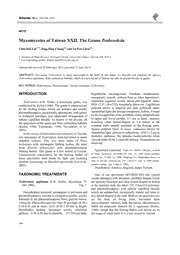
Myxomycetes of Taiwan XXII. The Genus Trabrooksia PDF
Preview Myxomycetes of Taiwan XXII. The Genus Trabrooksia
Taiwania, 56(3): 244-246, 2011 NOTE Myxomycetes of Taiwan XXII. The Genus Trabrooksia Chin-Hui Liu(1*), Jong-How Chang(1) and Ya-Fen Chen(1) 1. Institute of Plant Science, National Taiwan University, Taipei, Taiwan 106, R.O.C. * Corresponding author. Email: [email protected] (Manuscript received 25 Feberuary 2011; accepted 15 April 2011) ABSTRACT: The genus Trabrooksia is rarely discovered in the field. In this paper, we describe and illustrate the species, Trabrooksia applanata, from corticolous habitats, which is a new record of Taiwan not only in species but also in genus. KEY WORDS: Didymiaceae, Myxomycetes, Taiwan, taxonomy, Trabrooksia. INTRODUCTION Hypothallus inconspicuous. Peridium membranous, transparent, smooth, without lime or other depositions, somewhat rugulose, evenly pitted and papillate under Trabrooksia H.W. Keller, a monotypic genus, was SEM (Y.F. Chen223), irregularly dehiscent. Capillitium established by Keller (1980). The genus is characterized purplish brown to purplish red, pale yellowish under by the fruiting bodies which are limeless and usually transmitted light; the threads transparent, hollow, formed plasmodiocarpous, occasionally sporangiate, with glossy by the invagination of the peridium, nearly perpendicular to iridescent peridium, and subparallel arrangement of to upper and lower peridia, 2-3 µm in diam., sparsely tubular capillitial threads. As known to the present, all branched, often funnel-shaped or 2-4 forked at the the specimens of the genus are from corticolous habitats terminal ends, usually perforate at the forking parts. (Keller, 1980; Yamamoto, 1998; Novozhilov et al., Spores purplish black in mass, violaceous brown by 2003). transmitted light, globose to subglobose, 10.0-11.5 µm in In the survey of corticolous myxomycetes in Taiwan, diameter, spinulose, the spinules mushroom-like when two specimens of Trabrooksia were harvested in moist viewed under SEM. Columella lacking. Plasmodium not chamber cultures. One was from barks of Pinus observed. luchuensis with sporangiate fruiting bodies, the other from Illicium arborescens with plasmodiocarpous fruiting bodies. This genus is a new record to Taiwan. Specimens examined: Taipei Co.: Shulin, Ganyuan, on bark Characteristic examination for the fruiting bodies of of Pinus luchuensis, BY568M130b, Feb. 23, 1990 (moist-chamber these specimens were made by light and scanning culture: Jan. 17-Feb. 23, 1990). Pingtung Co.: Nanjenshan forest, on electron microscopy as described previously (Liu et al., bark of Illicium arborescens, Y.F. Chen223, June 8, 1996 (moist- 2002). chamber culture: Apr. 8-June 8, 1996). Distribution: America, England, Japan, Taiwan. TAXONOMIC TREATMENTS One of our specimens (BY568M130b) has typical sessile sporangia with abundant capillitial threads which Trabrooksia applanata H.W. Keller, Mycologia 72: are sparsely branched and often funnel-shaped or forked 396. 1980. Fig. 1 at the terminal ends, the other (Y.F. Chen223) pulvinate and plasmodiocarpous with tubular capillitial threads Fructification scattered, sporangiate or pulvinate and which are unbranched, occasionally forked, and more or plasmodiocarpous, circular to elongate in profile, sessile, less funnel-shaped at the ends. Both of our specimens are flattened in the plasmodiocarpous form, grayish brown, on the bark of living trees, harvested from iridescent. Plasmodiocarps less than 50 µm high, (0.20-) moist-chamber cultures, with distinctive characteristics 0.28-0.45 mm in diam., (0.32-)0.43-1.20 mm in length. fulfill the diagnostic features for T. applanata (Keller, Hypothallus lacking. Sporangia sessile, somewhat 1980), except that the fruiting bodies and spores are in globose, 0.30-0.50 mm in diameter, 175-350 µm high. the range of small limit. It is a new record to Taiwan. 244 September, 2011 Liu et al.: Trabrooksia from Taiwan Fig. 1. Trabrooksia applanata. A: Fruiting bodies. B: Spores, surface view. C: Spores, marginal view. D: A broken sporangium, by SEM. E: Apical features of the capillitial threads, by SEM. F: One capillitial thread, by SEM. G: Spore surface markings, by SEM. H: Spores and the hollow capillitial threads, by SEM. I: Outer surface of peridium, showing the pits, by SEM. Scale bar: A = 325 μm; B-C = 4 μm; D = 35 μm; E = 0.8 μm; F, H = 3.5 μm; G = 1 μm; I = 4.5 μm. LITERATURE CITED Trabrooksia, a new genus. Mycologia 72: 395-403. Novozhilov, Y. K., D. W. Mitchell and M. Schnittler. 2003. Liu, C.-H., F.-H. Yang and J.-H. Chang. 2002. Myxomycete biodiversity of the Colorado Plateau. Myxomycetes of Taiwan XIV. Three new records of Mycological Progress 2: 243-258. Trichiales. Taiwania 47: 97-105. Yamamoto, Y. 1998. The Myxomycetes Biota of Japan. Toyo Keller, H. W. 1980. Corticolous Myxomycetes VIII: Shorin Publishing, Tokyo, Japan. 700 pp. [in Japanese] 245 Taiwania Vol. 56, No. 3 臺灣黏菌(二十二):布魯氏黏菌屬(Trabrooksia) 劉錦惠(1*)、張仲豪(1)、陳雅芬(1) 1. 國立臺灣大學,生命科學院植物科學研究所,臺北市106,臺灣。 * 通信作者。Email: [email protected] (收稿日期:2011年2月25日;接受日期:2011年4月15日) 摘要:布魯氏黏菌在野外很少被發現,本篇描述扁平布魯氏黏菌 (Trabrooksia applanata), 此為臺灣新紀錄種,同時也是臺灣新紀錄屬。 關鍵詞:鈣皮黏菌科、真黏菌綱、臺灣、分類、布魯氏黏菌屬。 246
